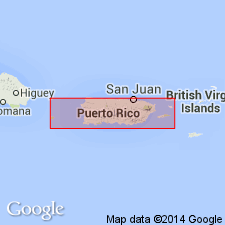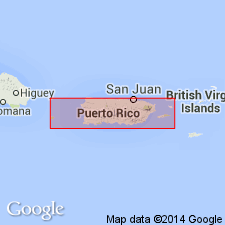
- Usage in publication:
-
- Punta Papayo Member
- Modifications:
-
- Named
- Dominant lithology:
-
- Mudstone
Summary:
Punta Papayo Member of the Parguera Limestone, here named, consists of mudstones with abundant open-ocean microfauna, minor calcarenite, bedded chert, and slump structures. Gradationally overlies the Bahia Fosforescente Member and underlies the Isla Magueyes Member, both of the Parguera.
Source: GNU records (USGS DDS-6; Reston GNULEX).

- Usage in publication:
-
- Punta Papayo†
- Modifications:
-
- Abandoned
Summary:
Parguera Formation is here restricted to the area south of the Lajas Valley because rocks mapped by Mattson(1960) as Parguera, north of the Lajas Valley, are lithologically different from the type Parguera. The Parguera is divided into an informal lower member, which includes Almy's Bahia Fosforescente and Punta Papaya Members of late Santonian to late Campanian age, and an informal upper member, which includes Almy's Isla Magueyes Member of late Campanian to early Maastrichtian age.
Source: GNU records (USGS DDS-6; Reston GNULEX).
For more information, please contact Nancy Stamm, Geologic Names Committee Secretary.
Asterisk (*) indicates published by U.S. Geological Survey authors.
"No current usage" (†) implies that a name has been abandoned or has fallen into disuse. Former usage and, if known, replacement name given in parentheses ( ).
Slash (/) indicates name conflicts with nomenclatural guidelines (CSN, 1933; ACSN, 1961, 1970; NACSN, 1983, 2005, 2021). May be explained within brackets ([ ]).

